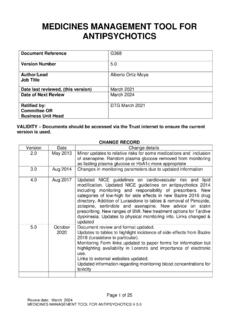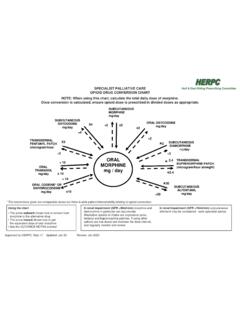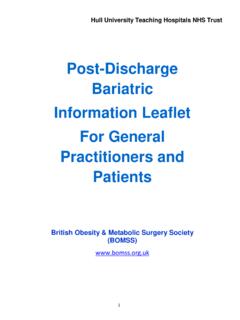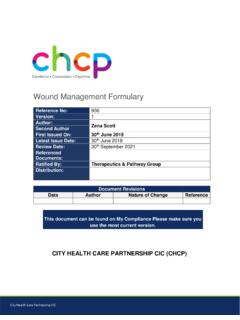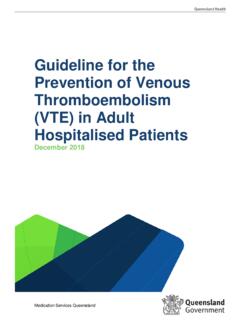Transcription of Guidelines on Prophylaxis of Venous Thromboembolism on ...
1 Hull & East Riding Prescribing Committee Prescribing Information for VTE Prophylaxis on discharge Date Approved by HERPC: Jan 15 Updated: Mar 20 Review: Mar 23 Page 1 of 6 Guidelines on Prophylaxis of Venous Thromboembolism on Transfer from Secondary Care 1. BACKGROUND Following publication of NICE NG89 all patients 16 years old and above admitted to hospital must be assessed for risk of Venous Thromboembolism . This includes in-patients, day cases and some out-patients. Patients are regarded as being at risk of VTE if they meet the following criteria (from NICE NG89) All forms of thromboprophylaxis are off-label for under 18 year Medical patients who have had or are expected to have significantly reduced mobility for 3 days or more or are expected to have ongoing reduced mobility relative to their normal state and have one or more of the VTE risk factors (see below) 2.
2 Surgical patients and patients with trauma who has had a surgical procedure with a total anaesthetic and surgical time of more than 90 minutes are an acute surgical admission with inflammatory or intra-abdominal condition are expected to have significant reduction in mobility have one or more of the risk factors shown below VTE risk factors Active cancer or cancer treatment Age > 60 years Critical care admission Dehydration Known thrombophilias Obesity (BMI > 30 kg/m2) One or more significant medical comorbidities (for example: heart disease; metabolic, endocrine or respiratory pathologies; acute infectious diseases; inflammatory conditions) Personal history or first-degree relative with a history of VTE Use of HRT Use of oestrogen-containing contraceptive therapy Varicose veins with phlebitis For women who are pregnant or have given birth within the previous 6 weeks (see NICE guidance or RCOG Guideline 37a for specific risk factors).
3 Hull & East Riding Prescribing Committee Prescribing Information for VTE Prophylaxis on discharge Date Approved by HERPC: Jan 15 Updated: Mar 20 Review: Mar 23 Page 2 of 6 For patients regarded as being at risk of VTE, bleeding risk will also be assessed and a clinical decision made on the type of Prophylaxis , if any, that should be offered to the patient. For many patients, Prophylaxis will be required only during hospital stay but for some, where risk of VTE remains significant ( patients whose mobility remains reduced relative to normal state) Prophylaxis may be required following discharge.
4 2. CHOICE OF VTE Prophylaxis Within Hull and East Riding the following methods of are used for VTE Prophylaxis . Mechanical Prophylaxis Includes anti - embolism stockings , foot impulse devices, and intermittent pneumatic compression devices. anti - embolism stockings are supplied by secondary care when needed for discharge. Pharmacological Prophylaxis (see Appendix for more information) Dalteparin (low molecular weight heparin, LMWH of choice. Other LMWH could be used at times of supply disruption) Standard dose 5000 units once daily by subcutaneous injection Fondaparinux (rarely - alternative to dalteparin when porcine product declined) Standard dose once daily by subcutaneous injection Dabigatran For Prophylaxis of VTE following total hip or knee replacement, or lower limb cast, fracture of hip/pelvis/proximal femur, non-arthroplasty knee surgery and other orthopaedic/spinal surgery if indicated [off label uses].
5 Standard dose - 220mg once daily Dose reduced to 150mg once daily (or rarely 75mg once daily) in patients 75 years and over, CrCl 30-50ml/min, patients taking amiodarone, verapamil. Course length: dependant on indication When dabigatran is contraindicated dalteparin will be used as alternative. Dabigatran is classified as RED drug for this indication full supply by secondary care NOTE Due to LMWH supply fluctuations, the other LMWH Enoxaparin and Tinzaparin are now in our formulary to be used accordingly if Dalteparin becomes unavailable. Guidance will be produced when needed.
6 Hull & East Riding Prescribing Committee Prescribing Information for VTE Prophylaxis on discharge Date Approved by HERPC: Jan 15 Updated: Mar 20 Review: Mar 23 Page 3 of 6 3. PROCEDURE WITHIN HULL AND EAST YORKSHIRE HOSPITALS NHS TRUST On admission all patients will be assessed for risk of VTE and prescribed Prophylaxis as per NICE NG89. Patients will be reassessed and a decision made regarding need for continued Prophylaxis on discharge. Patients likely to require VTE Prophylaxis on discharge include those with following risks Elective knee and hip replacement Hip fracture Other orthopaedic surgery (including day surgery) Major trauma Lower limb casts Reduced mobility following any surgical procedure or medical admission Pregnancy and/or 6 weeks following delivery as per RCOG Guideline 37a.
7 If VTE Prophylaxis is required following discharge, HUTH will Provide GP with information on o Risk assessment for VTE o Details of mechanical and/or pharmacological treatment provided o Baseline blood tests required for pharmacological treatments o Details of follow up required by GP or secondary care Supply up to 30 days of VTE Prophylaxis and sharps bin if subcutaneous injection (up to 42 days post-partum and fracture clinic patients) OR Supply complete course of treatment for patients on Dabigatran Make referral to district nursing team for administration of subcutaneous injection, if necessary Educate patient on VTE Prophylaxis , as per NICE NG89.
8 4. STANDARD FOLLOW UP REQUIRED For all patients on VTE Prophylaxis Consider contraindications, cautions, drug interactions and adverse effects of drugs prescribed for VTE Prophylaxis , during routine clinical care of patient and prescribing of any new drug treatment. (see or for further information). Dalteparin or Fondaparinux Prescribe additional sharps bin on FP10, if required For some patients, it will not be possible to determine the duration of reduced mobility at point of discharge ( patients with reduced mobility following medical admission, who are discharged to Intermediate Care).
9 For these patients Prophylaxis should be prescribed while patient remains at risk of VTE, usually until patient returns to normal state of mobility. For patients who do not require follow up with specialist, GP should assess mobility and on-going need for Prophylaxis . APPROVAL PROCESS Written by: Marie Miller, Interface Pharmacist Consultation process: MMIG Approved by: HEY Thrombosis Committee Dec 14 Ratified by: HERPC Jan 15, Updated Feb 19, March 2020 Review date: March 2023 Hull & East Riding Prescribing Committee Prescribing Information for VTE Prophylaxis on discharge Date Approved by HERPC: Jan 15 Updated: Mar 20 Review: Mar 23 Page 4 of 6 APPENDIX.
10 FURTHER INFORMATION ON PHARMACOLOGICAL Prophylaxis DALTEPARIN Indications (for VTE Prophylaxis ) Peri- and post-operative surgical thromboprophylaxis, including lower limb casts The Prophylaxis of proximal deep Venous thrombosis in patients bedridden due to a medical condition Thromboprophylaxis during pregnancy and following delivery Dose by subcutaneous injection For Prophylaxis 5000 units once daily reduced to 2500 units once daily in dialysis patients. Duration Prophylaxis is normally continued until patients mobility returns to normal state. Examples of typical duration are given below, but they will vary according to type of surgery or medical problem and patient s recovery.

